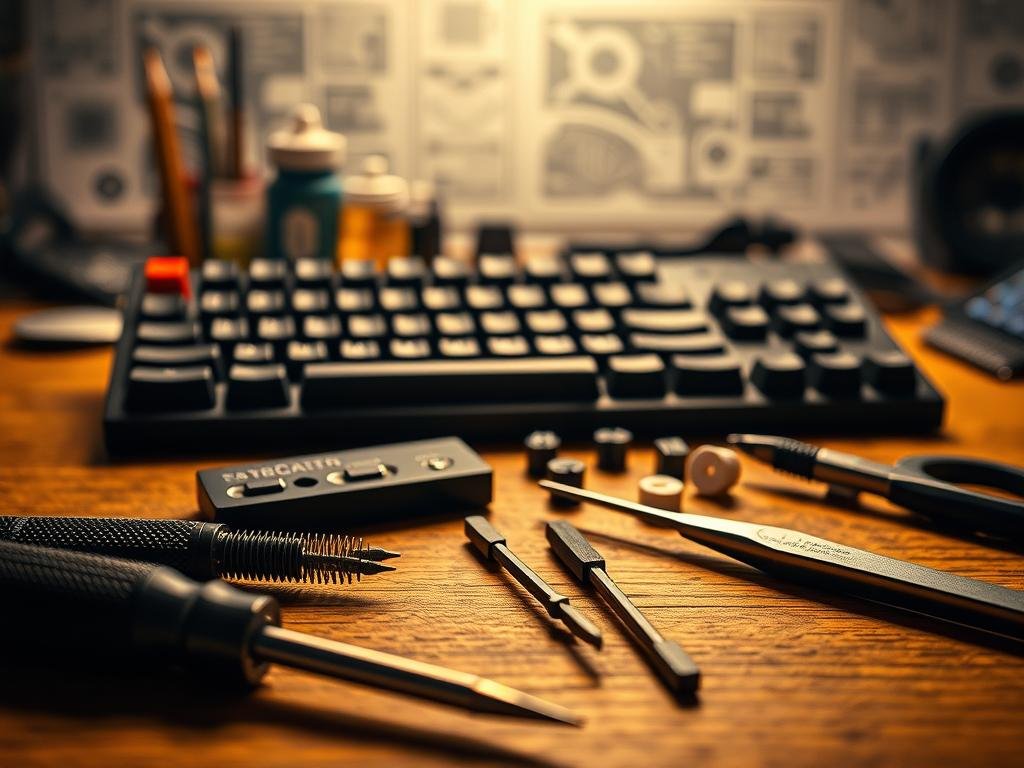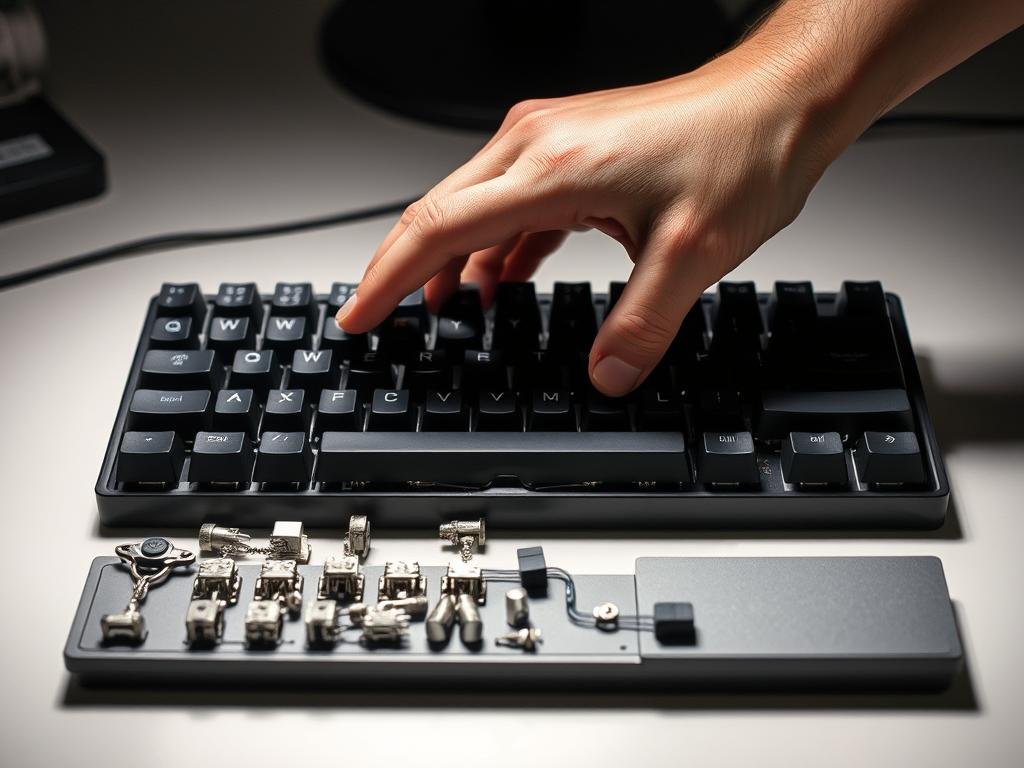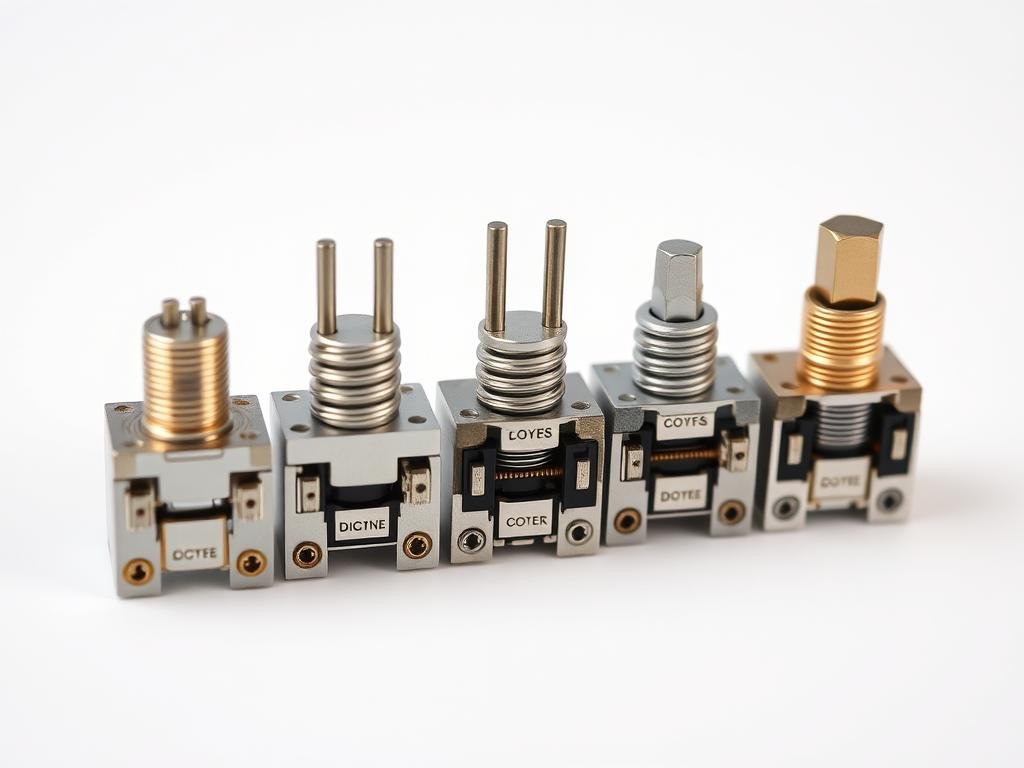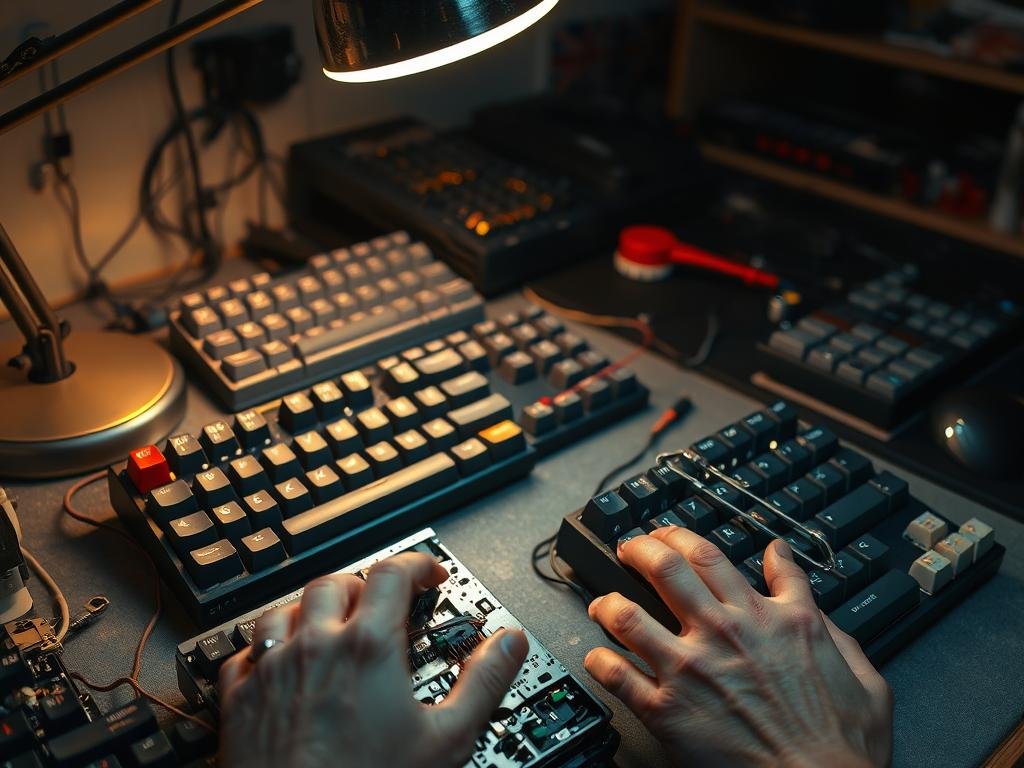Did you know many mechanical keyboard users deal with unresponsive or broken keys? Mechanical keyboards are loved for their durability and feel. But sometimes, they can have problems that make them hard to use.
When your mechanical keyboard keys stop working, it’s really annoying. Dust, key switch failure, or connection issues are common reasons. Luckily, you can fix many of these problems yourself. For a detailed guide on fixing unresponsive keys, check out this guide on mechanical keyboards.
Key Takeaways
- Regular cleaning can prevent key responsiveness issues.
- Inspecting and cleaning the keys and keyboard can resolve many issues.
- Checking the connection and cable for damage is a key troubleshooting step.
- Updating keyboard drivers or disabling Filter Keys can sometimes fix the problem.
- Advanced repair methods include keycap and switch replacement.
Understanding Mechanical Keyboards
Mechanical keyboards are different from membrane keyboards. They have individual switches under each key. This design improves typing and makes the keyboards last longer and more customizable.
What Makes Mechanical Keyboards Unique?
Mechanical keyboards stand out because of their individual switches. These switches give a tactile feel and a click sound. This is what many typists love.
There are many switch types, like linear, tactile, and clicky. This lets users pick the best switch for their typing style.
Customization is a big part of mechanical keyboards. Users can change keycap designs, materials, and layouts. This makes them very popular among gamers and typists.
Common Components of Mechanical Keyboards
A mechanical keyboard has several key parts:
- Switches: The heart of a mechanical keyboard, available in various types.
- Keycaps: Removable and replaceable caps that sit on top of the switches.
- PCB (Printed Circuit Board): The electronic board that connects the switches to the keyboard’s circuitry.
- Stabilizers: Mechanisms that support longer keys, like the space bar, to ensure even pressing.
- Case: The outer casing of the keyboard, available in various materials and designs.
| Component | Description | Importance |
|---|---|---|
| Switches | Individual mechanical switches under each key. | High |
| Keycaps | Removable caps on top of switches. | Medium |
| PCB | Electronic board connecting switches to circuitry. | High |
Benefits of Mechanical Keyboards
Mechanical keyboards improve typing accuracy and speed. The tactile feedback and distinct actuation point help a lot. They are also very durable, with switches lasting millions of keystrokes.
They also offer a lot of customization options. Users can make their keyboard fit their needs, whether for gaming, typing, or other uses. This flexibility and the better typing experience make them a favorite among keyboard fans.
Diagnosing Common Keyboard Issues
When your mechanical keyboard starts acting up, figuring out the problem is key. These keyboards are complex and customizable, making them tricky to fix.
Identifying Broken Keys
First, check if any keys are broken. This could be due to wear, dust, or a flaw in the making. Press each key to see if it works. You can also use software to scan for any keys that don’t respond.
Recognizing Connection Problems
Connection issues are common with mechanical keyboards. They can be caused by loose USBs, bad cables, or circuitry problems. Start by checking the USB connection. Make sure it’s snug in both the keyboard and computer.
If it’s not working, try a different USB port or cable. This helps figure out if the problem is with your setup.
Common signs of connection problems include:
- Intermittent keyboard functionality
- Keyboard not being recognized by the computer
- Erratic behavior such as random key presses
Troubleshooting Software Conflicts
At times, the problem might not be with the hardware but with software. This could be due to old drivers, conflicting software, or OS issues. Start by updating your keyboard drivers to the latest version. Check for any software that might be causing trouble and update or remove it if needed.
Steps to troubleshoot software conflicts:
- Update keyboard drivers
- Check for conflicting software
- Adjust keyboard settings within your operating system
Essential Tools for Repairs
To fix your mechanical keyboard, you need the right tools. Having the right equipment makes repairs smoother. It also helps you solve common problems quickly.
Tools You’ll Need
Several tools are key for fixing mechanical keyboards. These include:
- Keycap Puller: A keycap puller removes keycaps safely. It doesn’t damage them or the switches below.
- Switch Cleaner: Cleaning switches keeps them working well. A switch cleaner removes dust and dirt.
- Soldering Iron: For soldering repairs, a soldering iron is essential. It fixes broken connections.
- Precision Screwdrivers: These are needed to open the keyboard. They help you reach the inside parts.

Recommended Brands for Repair Kits
For repair kits, some brands are better than others. Keychron and WASD Keyboards are top choices. They offer kits with keycap pullers, switch cleaners, and more. These kits have everything you need for common repairs.
Buying a quality repair kit improves your DIY experience. It makes fixing your keyboard easier.
How to Replace a Keycap
A broken keycap can be a hassle, but it’s easy to replace. This can solve problems like a mechanical keyboard key not registering. Replacing a keycap is simple and can be done with basic tools.
Removing the Broken Keycap
To begin, remove the broken keycap. You can usually pull it straight off. Some keyboards might need a keycap puller, a tool made for this job.
- Gently grasp the keycap with your fingers or a keycap puller.
- Pull the keycap straight off. Avoid twisting or bending it, as this could damage the switch underneath.
- If the keycap is stubborn, you can gently wiggle it back and forth while pulling.
Installing a New Keycap
After removing the old keycap, you can put in a new one. Make sure the new keycap fits your keyboard’s switch type.
- Align the new keycap with the switch, ensuring it’s properly positioned.
- Gently press the keycap down onto the switch until it clicks into place.
- Test the key by pressing it several times to ensure it’s working correctly and not wobbly.
Replacing a keycap is a simple fix for a mechanical keyboard key not registering. If the problem continues after replacing the keycap, it might be a more serious issue. This could be a faulty switch, needing further repair or professional help.
| Step | Description | Tool Required |
|---|---|---|
| 1 | Remove the broken keycap | Keycap puller (optional) |
| 2 | Align and install the new keycap | None |
| 3 | Test the new keycap | None |
By following these steps, you can replace a keycap on your mechanical keyboard. This can fix issues like a key not registering and keep your keyboard working well.
Fixing Stuck Keys
If your mechanical keyboard has stuck keys, don’t panic. It’s usually easy to fix. Stuck keys can happen due to dust, debris, or spills. Knowing why it’s stuck helps you fix it right.
Identifying Causes of Stuck Keys
To fix a stuck key, first find out why it’s stuck. Dust, debris, spills, or switch wear can cause it. Look closely at the key and its surroundings to find the problem.

Cleaning the Affected Area
After finding the cause, clean the area. Use compressed air or a soft brush for dust and debris. For spills, you might need to deep clean your keyboard. This might mean removing keycaps to get to the problem spot.
Reassembling the Key
After cleaning, put the keycap back on the switch. Make sure it’s aligned right and press down until it clicks. Check if the key works now. If not, you might need a new keycap or switch.
By following these steps, you can usually fix stuck keys on your keyboard. This will make typing smooth and easy again.
Dealing with Key Switch Issues
Fixing key switch problems is key for anyone using a mechanical keyboard. These keyboards are loved for their feel and long life, thanks to their switches.
Understanding Different Switch Types
Mechanical keyboards come with different switch types. Linear switches feel smooth, tactile switches have a bump, and clicky switches make sound. Knowing these types helps you pick the right one or fix issues.

Testing Mechanical Switch Functionality
To find out if a switch is working, test it. See if it registers key presses right. Use software or a multimeter for this.
For a deeper check, use a switch tester or special software. It helps figure out if the problem is with the switch or the keyboard’s circuit.
Replacing Faulty Switches
Replacing a bad switch needs some know-how and the right tools. You’ll need a switch puller and a new switch that fits your keyboard’s PCB.
First, remove the old switch with a switch puller. Then, solder the new one to the PCB. Be careful not to harm the PCB or other parts.
Repairing Connection Problems
Fixing connection issues is key to getting your mechanical keyboard working again. These problems can come from bad USB connections, damaged cables, or faulty USB ports.
Checking USB Connections
Start by checking the USB connection. Make sure the USB cable is fully plugged into both the keyboard and your computer. A loose connection can make the keyboard stop working.
To check the connection:
- Unplug the USB cable from both the keyboard and your computer.
- Look for any dirt or damage on the USB connector.
- Plug the USB cable back in firmly to both devices.
Inspecting for Cable Damage
Damage to the USB cable is another common problem. Look for any cuts, frays, or bent pins on the cable.
If you see damage:
- Think about getting a new USB cable.
- Make sure the new cable fits your keyboard.
Utilizing Alternative USB Ports
It could also be a problem with your computer’s USB port. Try using a different USB port to see if it fixes the issue.
Here’s a quick guide to fixing connection problems:
| Step | Description | Action |
|---|---|---|
| 1 | Check USB Connection | Make sure the USB cable is securely plugged into both the keyboard and computer. |
| 2 | Inspect Cable | Check for any damage on the USB cable. |
| 3 | Try Alternative USB Port | Plug the keyboard into a different USB port on your computer. |

By following these steps, you can fix many connection problems with your mechanical keyboard. If you’re not able to solve the issue, you might need to try other solutions or get professional help.
Cleaning Your Mechanical Keyboard
Cleaning your mechanical keyboard often makes it last longer and work better. Dust, dirt, and other stuff can make keys stick and switches fail.
Best Practices for Keyboard Cleaning
To clean your keyboard well, start by turning it upside down and shaking it gently. This helps get rid of loose dirt. You can also use compressed air to clean out dust and dirt from between the keys and switches.
- Use a soft-bristled brush to gently sweep away dust and dirt from the keys and switches.
- Dampen a cloth with water, but make sure it’s not soaking wet, to wipe down the keys and keyboard surface.
- Avoid using harsh chemicals or abrasive cleaners that can damage the keyboard’s finish or harm the switches.
Recommended Cleaning Solutions
For a deeper clean, use special cleaning solutions made for electronics. These are usually safe for your keyboard’s materials and can get rid of tough dirt and grime.
For more info on cleaning and maintaining your mechanical keyboard, check out this forum discussion. It has tips and advice from the community.
Frequency of Cleaning
How often you should clean your keyboard depends on how much you use it. If you use it every day, clean it every few months to stop debris buildup.
By following these tips and using the right cleaning solutions, you can keep your mechanical keyboard in top shape. This ensures it keeps working well for a long time.
Preventative Maintenance Tips
Keeping your mechanical keyboard clean and well-maintained can prevent many problems. This includes dust buildup and switch failure. Regular care can make your keyboard last longer.
Regular Maintenance Importance
Keeping your mechanical keyboard in good shape is key. Cleaning it, checking for worn parts, and making sure connections are tight are important steps. These actions help avoid costly repairs or the need for a new keyboard.
- Regularly clean your keyboard to prevent dust and debris buildup.
- Inspect your keyboard for worn-out parts and replace them as needed.
- Check all connections to ensure they are secure and functioning properly.
Tips to Avoid Future Damage
To prevent damage, handle your keyboard with care. Don’t eat or drink near it to avoid spills. Also, keep it away from direct sunlight and extreme temperatures.
Handling Tips:
- Avoid consuming food or beverages near your keyboard.
- Keep your keyboard away from direct sunlight.
- Maintain a stable environment, avoiding extreme temperatures.
Proper Storage Techniques
Proper storage is important when your keyboard is not in use. Store it in a dry, cool place, away from dust. If you have the original packaging or a protective case, use it to prevent damage.
Storage Recommendations:
- Store in a dry, cool environment.
- Use original packaging or a protective case if available.
- Keep away from dusty areas.
When to Seek Professional Help
Many mechanical keyboard problems can be fixed by yourself. But, some issues need a pro’s touch. Knowing when to ask for help is key to avoid more damage and get a good fix.
Indicators of Complex Issues
If DIY fixes don’t work, it’s time to call a pro. Look out for signs like ongoing connection troubles, tricky switch issues, or PCB damage. These are clear signals you need expert help.
Finding a Reliable Repair Service
Seek out repair services with skilled technicians. Check online reviews and ask for recommendations. Make sure they use real parts. Companies like WASD Keyboards and Keyboard Company are known for their reliable services.
Understanding the Costs
Repair prices vary based on the problem and the service. You might spend $50 to $200 for complex fixes. Always ask for a detailed cost estimate before starting. This way, you’ll know exactly what you’re paying for.
FAQ
What are the most common issues with mechanical keyboards?
Common problems include broken keys, stuck keys, connection issues, and software conflicts. Regular care can help avoid these issues.
How do I diagnose a broken key on my mechanical keyboard?
First, press the key several times to see if it works. If it doesn’t, look for dust under the keycap. Clean it if you find any.
Can I replace a keycap on my mechanical keyboard myself?
Yes, you can replace a keycap yourself. You’ll need a keycap puller and a new keycap that fits.
How do I clean a stuck key on my mechanical keyboard?
Remove the keycap and clean the area with compressed air or a soft brush. If it’s stuck, use a switch cleaner.
What are the different types of key switches, and how do I test their functionality?
Key switches come in linear, tactile, and clicky types. Press the key several times to check for consistency. Use a switch tester for a detailed evaluation.
How do I repair a connection problem with my mechanical keyboard?
Check the USB connection and the cable for damage. Try using a different USB port. If it doesn’t work, you might need to replace the cable or fix the USB connector.
How often should I clean my mechanical keyboard?
Clean your keyboard every 1-3 months, depending on how much you use it. Regular cleaning keeps dust and debris away from the keys.
Can I prevent future damage to my mechanical keyboard?
Yes, prevent damage by cleaning your keyboard regularly. Avoid eating or drinking near it. Store it properly when not in use.
When should I seek professional help for my mechanical keyboard?
Seek professional help if you’re not sure how to fix a complex problem. If you’ve tried troubleshooting and it doesn’t work, a repair service can help.
How much does it cost to repair a mechanical keyboard?
Repair costs vary based on the issue, its complexity, and the service provider. Expect to pay between and 0 or more.
